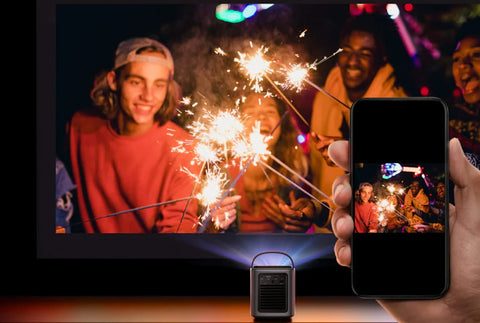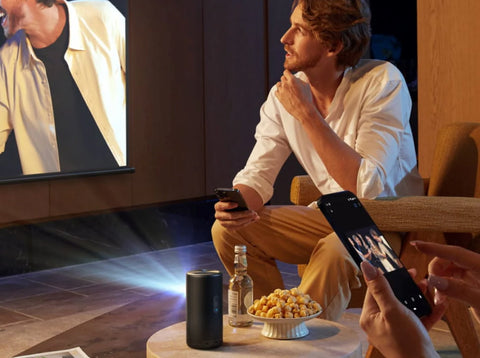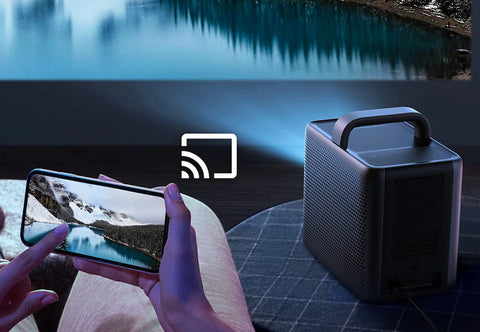How to Connect Phone to Projector Wirelessly: Step-by-Step Guide
The ability to connect projector wirelessly with our smartphones is not just a convenience, but a necessity. Whether you're giving a presentation, watching a movie, or sharing photos with friends and family on a large screen, connecting your phone to a projector wirelessly allows you to easily mirror your phone's screen without fumbling with cables. So, how can you do that?
In this guide, we'll walk you through four effective methods on how to connect phone to projector wirelessly, including Wi-Fi Direct, AirPlay, Miracast, and Chromecast. We'll also delve into troubleshooting common issues, ensuring you're well-equipped to handle any hiccups along the way.


Best Deals
Enjoy incredible savings Up to 500$ with NEBULA's latest discounts! Grab our newest smart projector and transform any space into a big screen experience today !
How To Connect Your Phone to A Projector Wirelessly
Connecting your phone to a projector wirelessly is a highly convenient method for displaying presentations, videos, photos, or any other content on a larger screen. Here are the most common methods to achieve this phone to projector wireless connection:
Wi-Fi Direct Connection
Wi-Fi Direct is a convenient method that allows you to connect your phone directly to a projector without the need for a Wi-Fi router. This is often the preferred method to connect Android phone to projector wirelessly, as Wi-Fi Direct is integrated into all Android phones.
To use this method, you'll need a Wi-Fi projector equipped with Wi-Fi Direct capability. So, check the detailed specifications or user manuals of your projector to verify. Here's how to use it:
- Activate Wi-Fi Direct on Your Projector: Navigate to the network settings menu of your projector and look for the Wi-Fi Direct option. Activate it, and the projector will start broadcasting its own Wi-Fi network.
- Connect Your Phone to the Projector: Open the Wi-Fi settings on your phone. You should see the projector's Wi-Fi Direct network listed among the available networks. Connect to it as you would with any Wi-Fi network, entering a password if required.
- Mirror Your Screen: Once the connection is established, access the screen mirroring feature on your phone. This option is typically found in the display settings or the quick settings panel. Select your projector from the list of available devices to start mirroring your screen.
Airplay Connection
For iPhone users, AirPlay offers a seamless way to build a wireless connection to projector. This method requires that both the projector and your iPhone are connected to the same Wi-Fi network:
- Check for AirPlay Compatibility: Check if your projector has built-in AirPlay support. If not, you may need an external device like an Apple TV to enable AirPlay functionality.
- Connect to the same Wi-Fi network: Make sure both your iPhone and the projector are connected to the same Wi-Fi network. This is essential for AirPlay to work.
- Use Screen Mirroring: Swipe down from the upper right corner of your screen (on iPhone X or later) or up from the bottom edge (on iPhone 8 or earlier) to access the Control Center. Tap on the "Screen Mirroring" option and select your projector or connected Apple TV from the list. Your iPhone's screen will now be mirrored on the projector.

Miracast
Miracast is a wireless standard that allows Android phones to connect to a projector wirelessly. It creates a direct connection between the two devices, similar to Wi-Fi Direct:
- Check Compatibility: First, ensure both your Android phone and projector support Miracast. This is usually indicated in the device specifications.
- Enable Miracast on Your Projector: Look for the "Miracast" or "Wireless Display" option in your projector's settings and enable it. This makes your projector visible to your phone.
- Connect Your Phone: On your Android phone, go to Settings > Display > Cast (the pathway might vary depending on your device). Your device will search for the projector. Once your projector appears in the list, tap on it to initiate the connection. After a brief moment, your phone's screen should be mirrored on the projector.
Guide Tutorial: Watch the video to learn how to mirror from a phone
Chromecast
Chromecast is popular method for casting content from smartphones to larger screens, compatible with all Android devices. Many modern projectors, like the Nebula Capsule 3, now come with Chromecast built-in, simplifying the process of streaming content directly from your phone. Here's how to connect:
- Verify Compatibility: Ensure that your projector's specifications mention Chromecast support. This allows for a seamless connection without additional hardware.
- Connect Your Phone: Both your Android smartphone and the projector need to be connected to the same Wi-Fi network. Open an app that supports Chromecast – such as YouTube, Spotify, or Google Slides – and tap on the "Cast" icon (it looks like a screen with Wi-Fi waves). Select your projector from the list of available devices.
- Start Casting: Once connected, your selected content will start playing on the projector. You can control the playback directly from your phone.
If your projector lacks built-in Chromecast, you can also plug a Chromecast streaming device into an HDMI port on your projector to enable this feature. Here's how to use it:
- Plug in the Chromecast Device: Connect the Chromecast device to your projector's HDMI port and power it on.
- Set Up the Chromecast: If it's your first time using Chromecast, follow the setup instructions using the Google Home app on your phone. This involves linking the Chromecast to your Wi-Fi network and configuring it for use.
- Cast Content: Open a compatible app you want to cast from on your phone and look for the "Cast" icon. Tap on it and select your Chromecast device. Your phone's screen will now be displayed through the projector.
- Screen Mirroring Option: For full screen mirroring, use the Google Home app to select your Chromecast device and choose the "Cast my screen" option. This mirrors your phone's display onto the projector, ideal for browsing, gaming, or displaying apps not directly supporting Chromecast.

Troubleshooting Common Issues
Connecting your phone to a wireless phone projector using these methods can be a convenient way to share presentations, videos, or photos with a larger audience. However, occasional hiccups can occur.
If you're having trouble connecting to projector wirelessly, here are some common issues and their solutions to help you resolve them swiftly:
Device Not Found
If your phone cannot find the projector or vice versa, ensure both devices are compatible with the connection method you're trying to use (e.g., Wi-Fi Direct, AirPlay, Miracast, Chromecast). Also, check that both devices are on the same Wi-Fi network if you are using AirPlay or Chromecast. Try restart both devices to refresh their network discovery capabilities.
Unstable or No Connection
An unstable connection or failure to connect can often be attributed to network issues or interference. Move closer to the router or projector to ensure a stronger Wi-Fi signal. Check for interference from other Wi-Fi networks or devices and try switching to a different Wi-Fi channel or frequency. Additionally, restarting your router to clear any network congestion can also help.
Poor Video/Audio Quality
If you're experiencing lag, buffering, or low-quality video or audio, this could be due to network bandwidth or device performance. Try closing unnecessary apps on your phone to free up resources. Check your network speed and ensure it's sufficient for high-quality streaming. Consider upgrading your internet plan if necessary. Reduce the streaming quality settings if possible to accommodate lower bandwidths.
Compatibility Issues
Sometimes, devices might not be compatible due to different standards or outdated software. Check for and install any available updates for your phone and projector firmware. If you are using Wi-Fi Direct or Miracast to link your phone to projector with wireless connection, verify that both devices support the latest version of the technology. If you're still experiencing issues, consider using a third-party app that can bridge compatibility gaps between your phone and projector.
Conclusion
Understanding how to connect phone to projector wirelessly can greatly enhance your multimedia experiences, whether for professional presentations, educational purposes, or personal entertainment. Throughout this guide, we've explored a variety of methods - Wi-Fi Direct, AirPlay, Miracast, and Chromecast - to help you find the solution that best fits your needs. We've also tackled some common troubleshooting issues to ensure you're well-prepared for any hiccups along the way. Remember, the key to a successful connection lies in understanding the compatibility of your devices and the steps involved in each method. So, go ahead, connect your phone to your projector wirelessly, and unlock a new dimension of visual experience.
FAQ
Can all phones connect to a projector wirelessly?
No. Not all phones can connect to a projector wirelessly. The capability depends on the phone’s hardware and software compatibility with the projector’s wireless technology. Most modern smartphones with Wi-Fi and screen mirroring or casting features can connect to wireless projectors. However, older models or those with limited connectivity options may not support wireless projection.
Do I need a special app to connect my phone to a projector wirelessly?
No, you do not necessarily need a special app to connect your phone to a projector wirelessly. Many modern smartphones and projectors support technologies like Wi-Fi Direct, Chromecast, or AirPlay that allow for wireless connection without the need for an additional app. However, the exact method can vary depending on the brand and model of your phone and projector. In other cases, you do need a dedicated app to facilitate the connection.
How can I connect my phone to a projector without USB?
To connect your phone to a projector without a USB, consider these methods: Use wireless technologies like Miracast or AirPlay for direct screen mirroring, or an HDMI adapter to link your phone's USB-C or Lightning port to the projector. Alternatively, explore dedicated apps provided by projector manufacturers for a seamless connection, or employ streaming devices like Chromecast by plugging them into the projector and casting from your phone.

